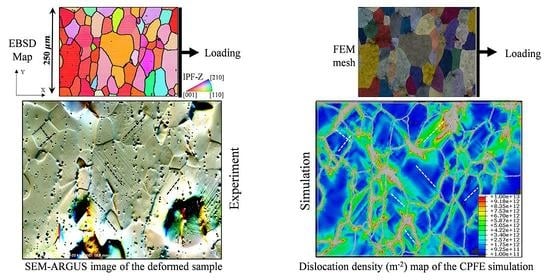Strain-Gradient Crystal Plasticity Finite Element Modeling of Slip Band Formation in α-Zirconium
Abstract
:1. Introduction
2. Sample Preparation and Experimental Set Up
3. Crystal Plasticity Formulation and Input Model
3.1. Crystal Plasticity Constitutive Equations
3.1.1. Method I
3.1.2. Method II
3.2. Input Models
3.2.1. Single Crystal
3.2.2. Polycrystal
4. Results
4.1. Single Crystal
4.2. Polycrystal
4.2.1. GND Density and Slip Activity
4.2.2. Stress
4.2.3. Lattice Rotations
5. Discussion
6. Conclusions
- The GND maps calculated from the strain-gradient CPFE models using both methods show formation of localized GND lines within the grains of the polycrystal. These GND lines are parallel to the slip bands observed in the deformed specimen using electron microscopy. The slip bands can also be seen in the CPFE-calculated shear strain maps.
- The use of the minimization-based approach for the determination of GND densities (Method II) leads to a uniform distribution of GNDs on all slip systems, whereas when the direct approach (Method I) is used, the magnitude of the calculated GNDs on each slip system is proportional to the plastic shear strain accumulated on the same slip system.
- Although the magnitudes of GND densities are different from the two methods, the trends observed for the calculated grain-scale stresses and lattice rotations are the same. This is because for the studied microstructure, where the average grain size is 50 µm, the calculated total dislocation density, GND plus SSD, from the two methods is almost the same.
- When a smaller grain size is used, the calculated average stresses from the two methods are different. The critical grain size below which the geometrical effects become significant is higher in Method II, compared to Method I.
- The dislocation-based hardening law used here is SSD driven for larger grains and GND driven for smaller grains, and accurate implementation of both mechanisms is important when different grain sizes exist in the microstructure.
Author Contributions
Funding
Data Availability Statement
Conflicts of Interest
References
- Rovinelli, A.; Proudhon, H.; Lebensohn, R.A.; Sangid, M.D. Assessing the reliability of fast Fourier transform-based crystal plasticity simulations of a polycrystalline material near a crack tip. Int. J. Solids Struct. 2020, 184, 153–166. [Google Scholar] [CrossRef]
- Petkov, M.P.; Hu, J.; Tarleton, E.; Cocks, A.C.F. Comparison of self-consistent and crystal plasticity FE approaches for modelling the high-temperature deformation of 316H austenitic stainless steel. Int. J. Solids Struct. 2019, 171, 54–80. [Google Scholar] [CrossRef]
- Ma, R.; Truster, T.J.; Puplampu, S.B.; Penumadu, D. Investigating mechanical degradation due to fire exposure of aluminum alloy 5083 using crystal plasticity finite element method. Int. J. Solids Struct. 2018, 134, 151–160. [Google Scholar] [CrossRef]
- Lu, X.; Zhang, X.; Shi, M.; Roters, F.; Kang, G. Dislocation mechanism based size-dependent crystal plasticity modeling and simulation of gradient nano-grained copper. Int. J. Plast. 2019, 113, 52–73. [Google Scholar] [CrossRef]
- Han, F.; Roters, F.; Raabe, D. Microstructure-based multiscale modeling of large strain plastic deformation by coupling a full-field crystal plasticity-spectral solver with an implicit finite element solver. Int. J. Plast. 2020, 125, 97–117. [Google Scholar] [CrossRef]
- Kasemer, M.; Dawson, P. A finite element methodology to incorporate kinematic activation of discrete deformation twins in a crystal plasticity framework. Comput. Methods Appl. Mech. Eng. 2020, 358, 1–29. [Google Scholar] [CrossRef]
- Wijnen, J.; Peerlings, R.H.J.; Hoefnagels, J.P.M.; Geers, M.G.D. A discrete slip plane model for simulating heterogeneous plastic deformation in single crystals. Int. J. Solids Struct. 2021, 228, 111094. [Google Scholar] [CrossRef]
- Nemat-nasser, S.; Ni, L.; Okinaka, T. A constitutive model for fcc crystals with application to polycrystalline OFHC copper. Mech. Mater. 1998, 30, 325–341. [Google Scholar] [CrossRef]
- Kocks, U.F.; Argon, A.S.; Ashby, M.F. Thermodynamics and Kinetics of Slip; Pergamon Press: Cambridge, UK, 1975. [Google Scholar]
- Evers, L.P.; Brekelmans, W.A.M.; Geers, M.G.D. Non-local crystal plasticity model with intrinsic SSD and GND effects. J. Mech. Phys. Solids 2004, 52, 2379–2401. [Google Scholar] [CrossRef]
- Ashby, M.F. The deformation of plastically non-homogeneous materials. Philos. Mag. 1970, 21, 399–424. [Google Scholar] [CrossRef]
- Taylor, G.I. The Mechanism of Plastic Deformation of Crystals. Part 1. Theoretical. Proc. R. Soc. 1934, 538, 362–387. [Google Scholar]
- Arsenlis, A.; Parks, D.M. Modeling the evolution of crystallographic dislocation density in crystal plasticity. J. Mech. Phys. Solids 2002, 50, 1979–2009. [Google Scholar] [CrossRef]
- Arsenlis, A.; Parks, D.M.; Becker, R.; Bulatov, V.V. On the evolution of crystallographic dislocation density in non-homogeneously deforming crystals. J. Mech. Phys. Solids 2004, 52, 1213–1246. [Google Scholar] [CrossRef]
- Gurtin, M.E. A gradient theory of single-crystal viscoplasticity that accounts for geometrically necessary dislocations. J. Mech. Phys. Solids 2002, 50, 5–32. [Google Scholar] [CrossRef]
- Niordson, C.F.; Hutchinson, J.W. On lower order strain gradient plasticity theories. Eur. J. Mech. A/Solids 2003, 22, 771–778. [Google Scholar] [CrossRef]
- Bassani, J.L. Incompatibility and a simple gradient theory of plasticity. J. Mech. Phys. Solids 2001, 49, 1983–1996. [Google Scholar] [CrossRef]
- Busso, E.P.; Meissonnier, F.T.; Dowd, N.P.O. Gradient-dependent deformation of two-phase single crystals. J. Mech. Phys. Solids 2000, 48, 2333–2361. [Google Scholar] [CrossRef]
- Arsenlis, A.; Parks, D.M. Crystallographic aspects of geometrically nesesary and statistically stored dislocation density. Acta Mater. 1999, 47, 1597–1611. [Google Scholar] [CrossRef]
- De Borst, R.; Mühlhaus, H.-B. Gradient-dependent plasticity: Formulation and algorithmic aspects. Int. J. Numer. Methods Eng. 1992, 35, 521–539. [Google Scholar] [CrossRef] [Green Version]
- Gao, H.; Huang, Y.; Nix, W.D.; Hutchinson, J.W. Mechanism-based strain gradient plasticity—I. Theory. J. Mech. Phys. Solids 1999, 47, 1239–1263. [Google Scholar] [CrossRef]
- Yun, G.; Hwang, K.C.; Huang, Y.; Wu, P.D. A reformulation of mechanism-based strain gradient plasticity. Philos. Mag. 2005, 85, 4011–4029. [Google Scholar] [CrossRef]
- Gurtin, M.E. On the plasticity of single crystals: Free energy, microforces, plastic-strain gradients. J. Mech. Phys. Solids 2000, 48, 989–1036. [Google Scholar] [CrossRef]
- Nye, J. Some geometrical relations in dislocated crystals. Acta Metall. 1953, 1, 153–162. [Google Scholar] [CrossRef]
- Das, S.; Hofmann, F.; Tarleton, E. Consistent determination of geometrically necessary dislocation density from simulations and experiments. Int. J. Plast. 2018, 109, 18–42. [Google Scholar] [CrossRef]
- Dai, H. Geometrically-Necessary Dislocation Density in Continuum Plasticity Theory. Ph.D. Thesis, Massachusetts Institute of Technology, Cambridge, MA, USA, 1997. [Google Scholar]
- Ma, A.; Roters, F.; Raabe, D. A dislocation density based constitutive model for crystal plasticity FEM including geometrically necessary dislocations. Acta Mater. 2006, 54, 2169–2179. [Google Scholar] [CrossRef]
- Dunne, F.P.E.; Rugg, D.; Walker, A. Lengthscale-dependent, elastically anisotropic, physically-based hcp crystal plasticity: Application to cold-dwell fatigue in Ti alloys. Int. J. Plast. 2007, 23, 1061–1083. [Google Scholar] [CrossRef]
- Waheed, S.; Zheng, Z.; Balint, D.S.; Dunne, F.P.E. Microstructural effects on strain rate and dwell sensitivity in dual-phase titanium alloys. Acta Mater. 2019, 162, 136–148. [Google Scholar] [CrossRef]
- Arsenlis, A. Modeling Dislocation Density Evolution in Continuum Crystal Plasticity. Available online: http://dspace.mit.edu/handle/1721.1/36679%5Cnhttps://dspace.mit.edu/handle/1721.1/36679 (accessed on 16 July 2001).
- Chen, B.; Jansenss, K.; Dunne, F.P.E. Role of geometrically necessary dislocation density in multiaxial and non-proportional fatigue crack nucleation. Int. J. Fatigue 2020, 135, 105517. [Google Scholar] [CrossRef]
- Wilson, D.; Dunne, F.P.E. A mechanistic modelling methodology for microstructure-sensitive fatigue crack growth. J. Mech. Phys. Solids 2019, 124, 827–848. [Google Scholar] [CrossRef]
- Dunne, F.P.E.; Kiwanuka, R.; Wilkinson, A.J. Crystal plasticity analysis of micro-deformation, lattice rotation and geometrically necessary dislocation density. Proc. R. Soc. A Math. Phys. Eng. Sci. 2012, 468, 2509–2531. [Google Scholar] [CrossRef] [Green Version]
- Cheng, J.; Ghosh, S. A crystal plasticity FE model for deformation with twin nucleation in magnesium alloys. Int. J. Plast. 2015, 67, 148–170. [Google Scholar] [CrossRef]
- Wu, W.; An, K.; Huang, L.; Lee, S.Y.; Liaw, P.K. Deformation dynamics study of a wrought magnesium alloy by real-time in situ neutron diffraction. Scr. Mater. 2013, 69, 358–361. [Google Scholar] [CrossRef]
- Xu, F.; Holt, R.A.; Daymond, M.R.; Rogge, R.B.; Oliver, E.C. Development of internal strains in textured Zircaloy-2 during uni-axial deformation. Mater. Sci. Eng. A 2008, 488, 172–185. [Google Scholar] [CrossRef]
- Louca, K.; Abdolvand, H. Accurate determination of grain properties using three-dimensional synchrotron X-ray diffraction: A comparison with EBSD. Mater. Charact. 2021, 171, 110753. [Google Scholar] [CrossRef]
- Abdolvand, H.; Louca, K.; Mareau, C.; Majkut, M.; Wright, J. On the nucleation of deformation twins at the early stages of plasticity. Acta Mater. 2020, 196, 733–746. [Google Scholar] [CrossRef]
- Abdolvand, H.; Wright, J.P.; Wilkinson, A.J. On the state of deformation in a polycrystalline material in three-dimension: Elastic strains, lattice rotations, and deformation mechanisms. Int. J. Plast. 2018, 106, 145–163. [Google Scholar] [CrossRef]
- Wallis, D.; Parsons, A.J.; Hansen, L.N. Quantifying geometrically necessary dislocations in quartz using HR-EBSD: Application to chessboard subgrain boundaries. J. Struct. Geol. 2019, 125, 235–247. [Google Scholar] [CrossRef]
- Ungar, T.; Drakopoulos, M.; Be, J.L.; Chauveau, T.; Castelnau, O.; Riba, G.; Snigirev, A.; Snigireva, I.; Schroer, C.; Bacroix, B. Grain to grain slip activity in plastically deformed Zr determined by X-ray micro-diffraction line profile analysis. Acta Mater. 2007, 55, 1117–1127. [Google Scholar] [CrossRef]
- Wilkinson, A.J.; Meaden, G.; Dingley, D.J. High-resolution elastic strain measurement from electron backscatter diffraction patterns: New levels of sensitivity. Ultramicroscopy 2006, 106, 307–313. [Google Scholar] [CrossRef] [PubMed]
- Wilkinson, A.J. Measurement of elastic strains and small lattice rotations using electron back scatter diffraction. Ultramicroscopy 1996, 62, 237–247. [Google Scholar] [CrossRef]
- Troost, K.Z.; Van Der Sluis, P.; Gravesteijn, D.J. Microscale elastic-strain determination by backscatter Kikuchi diffraction in the scanning electron microscope. Appl. Phys. Lett. 1993, 62, 1110–1112. [Google Scholar] [CrossRef]
- Guo, Y.; Abdolvand, H.; Britton, T.B.; Wilkinson, A.J. Growth of {112¯2} twins in titanium: A combined experimental and modelling investigation of the local state of deformation. Acta Mater. 2017, 126, 221–235. [Google Scholar] [CrossRef]
- Britton, T.B.; Wilkinson, A.J. High resolution electron backscatter diffraction measurements of elastic strain variations in the presence of larger lattice rotations. Ultramicroscopy 2012, 114, 82–95. [Google Scholar] [CrossRef] [PubMed]
- Sedaghat, O.; Abdolvand, H. A non-local crystal plasticity constitutive model for hexagonal close-packed polycrystals. Int. J. Plast. 2021, 136, 102883. [Google Scholar] [CrossRef]
- Zhang, Z.; Lunt, D.; Abdolvand, H.; Wilkinson, A.J.; Preuss, M.; Dunne, F.P.E. Quantitative investigation of micro slip and localization in polycrystalline materials under uniaxial tension. Int. J. Plast. 2018, 108, 88–106. [Google Scholar] [CrossRef] [Green Version]
- Abdolvand, H.; Sedaghat, O.; Guo, Y. Nucleation and growth of {112¯2} twins in titanium: Elastic energy and stress fields at the vicinity of twins. Materialia 2018, 2, 58–62. [Google Scholar] [CrossRef]
- Abdolvand, H.; Wright, J.; Wilkinson, A.J. Strong grain neighbour effects in polycrystals. Nat. Commun. 2018, 9, 171. [Google Scholar] [CrossRef] [Green Version]
- Abdolvand, H.; Wilkinson, A.J. On the effects of reorientation and shear transfer during twin formation: Comparison between high resolution electron backscatter diffraction experiments and a crystal plasticity finite element model. Int. J. Plast. 2016, 84, 160–182. [Google Scholar] [CrossRef] [Green Version]
- Asaro, R.J.; Needleman, A. Overview No. 42 Texture development and strain hardening in rate dependent polycrystals. Acta Metall. 1985, 33, 923–953. [Google Scholar] [CrossRef]
- Asaro, R.J. Crystal Plasticity. J. Appl. Mech. 1983, 50, 921–934. [Google Scholar] [CrossRef]
- Fisher, E.S.; Renken, C.J. Single-crystal elastic moduli and the hcp → bcc transformation in Ti, Zr, and Hf. Phys. Rev. 1964, 135, A482–A494. [Google Scholar] [CrossRef]
- Beyerlein, I.J.; Tomé, C.N. A dislocation-based constitutive law for pure Zr including temperature effects. Int. J. Plast. 2008, 24, 867–895. [Google Scholar] [CrossRef]
- Cheong, K.S.; Busso, E.P.; Arsenlis, A. A study of microstructural length scale effects on the behaviour of FCC polycrystals using strain gradient concepts. Int. J. Plast. 2005, 21, 1797–1814. [Google Scholar] [CrossRef] [Green Version]
- Abdolvand, H. Progressive modelling and experimentation of hydrogen diffusion and precipitation in anisotropic polycrystals. Int. J. Plast. 2019, 116, 39–61. [Google Scholar] [CrossRef]
- Abdolvand, H.; Daymond, M.R.; Mareau, C. Incorporation of twinning into a crystal plasticity finite element model: Evolution of lattice strains and texture in Zircaloy-2. Int. J. Plast. 2011, 27, 1721–1738. [Google Scholar] [CrossRef]
- Wallis, D.; Hansen, L.N.; Britton, T.B.; Wilkinson, A.J. High-Angular Resolution Electron Backscatter Diffraction as a New Tool for Mapping Lattice Distortion in Geological Minerals. J. Geophys. Res. Solid Earth 2019, 124, 6337–6358. [Google Scholar] [CrossRef]
- Wallis, D.; Hansen, L.N.; Ben Britton, T.; Wilkinson, A.J. Geometrically necessary dislocation densities in olivine obtained using high-angular resolution electron backscatter diffraction. Ultramicroscopy 2016, 168, 34–45. [Google Scholar] [CrossRef] [Green Version]
- Kuroda, M.; Tvergaard, V. Studies of scale dependent crystal viscoplasticity models. J. Mech. Phys. Solids 2006, 54, 1789–1810. [Google Scholar] [CrossRef]
- Baudoin, P.; Hama, T.; Takuda, H. Influence of critical resolved shear stress ratios on the response of a commercially pure titanium oligocrystal: Crystal plasticity simulations and experiment. Int. J. Plast. 2019, 115, 111–131. [Google Scholar] [CrossRef]
- Zeghadi, A.; Forest, S.; Gourgues, A.F.; Bouaziz, O. Ensemble averaging stress-strain fields in polycrystalline aggregates with a constrained surface microstructure-part 2: Crystal plasticity. Philos. Mag. 2007, 87, 1425–1446. [Google Scholar] [CrossRef]
- St-Pierre, L.; Héripré, E.; Dexet, M.; Crépin, J.; Bertolino, G.; Bilger, N. 3D simulations of microstructure and comparison with experimental microstructure coming from O.I.M analysis. Int. J. Plast. 2008, 24, 1516–1532. [Google Scholar] [CrossRef]



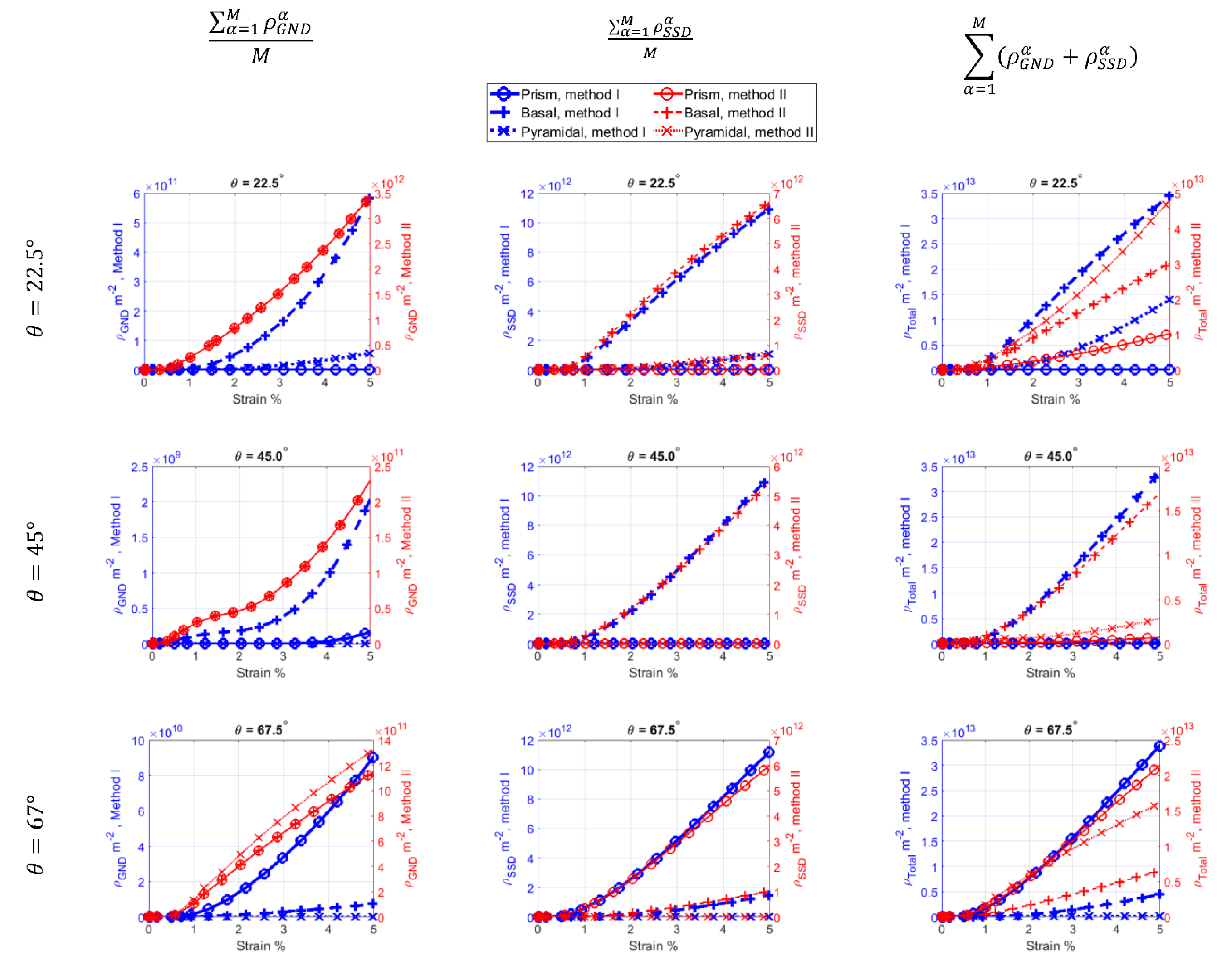
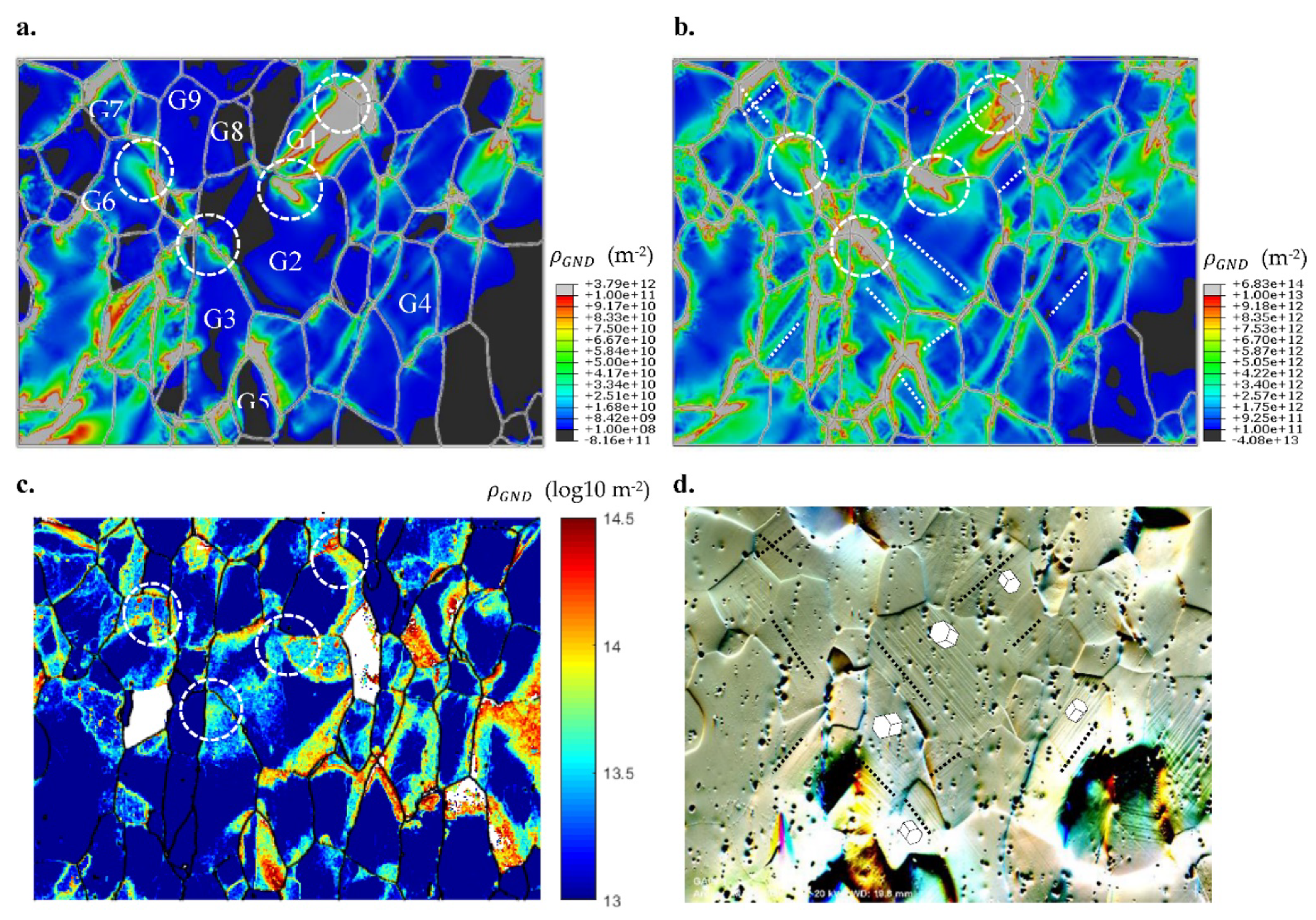
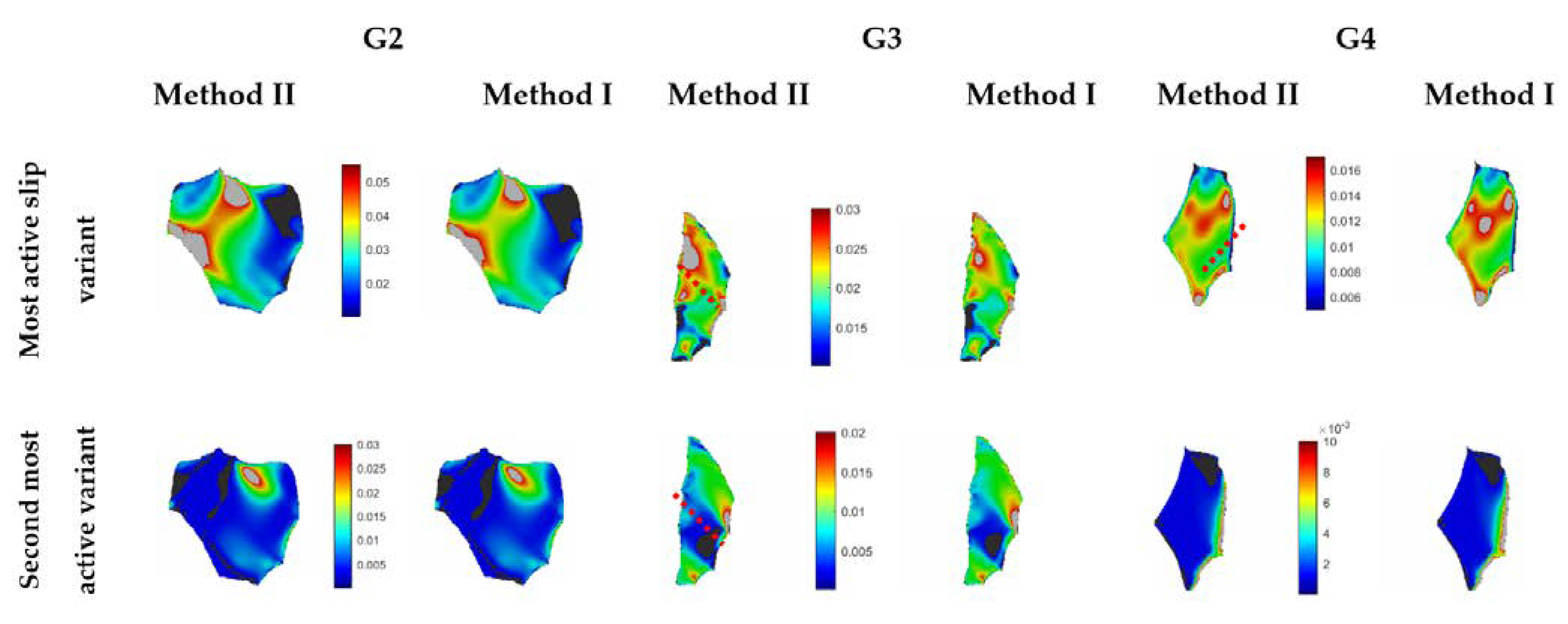

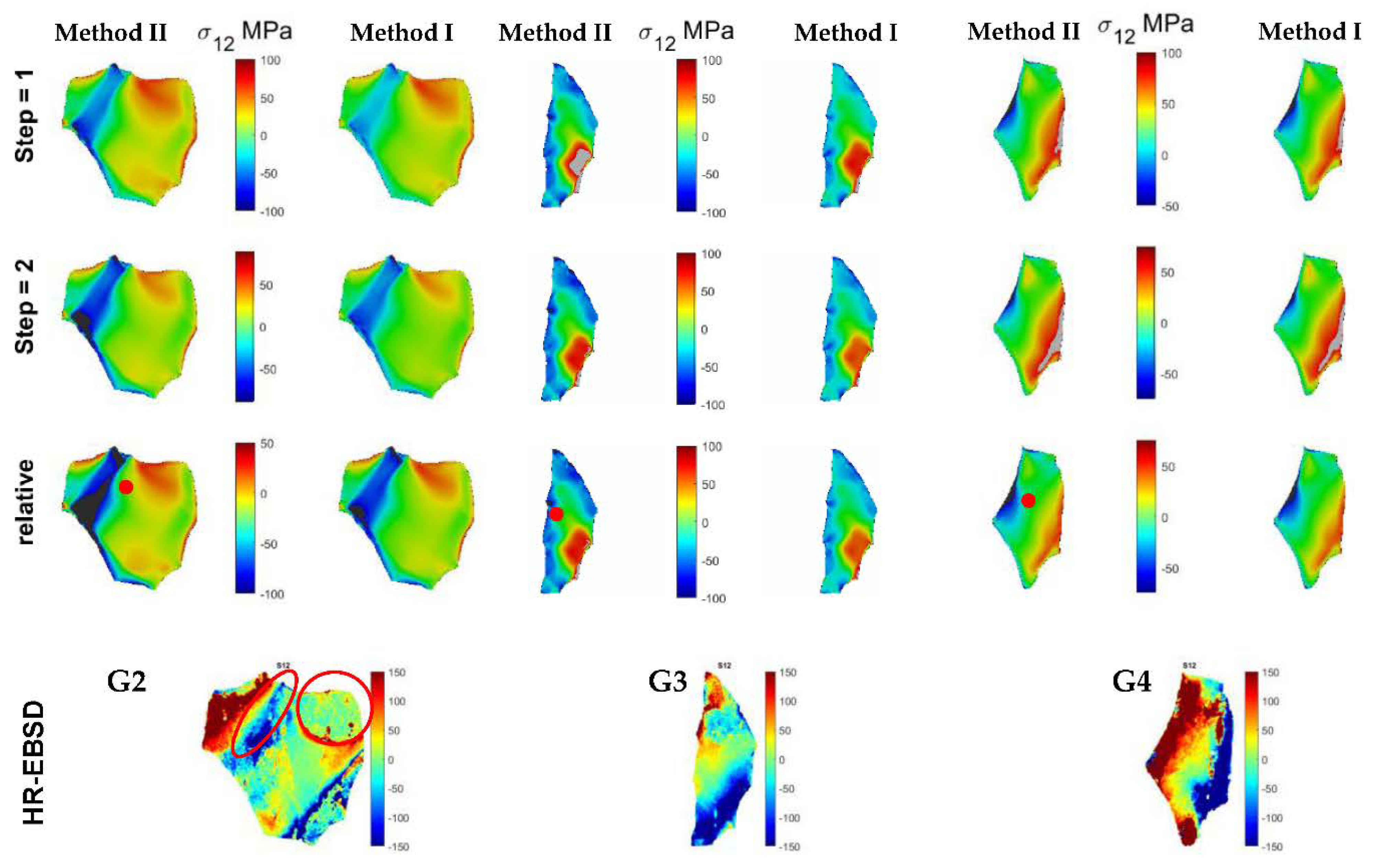
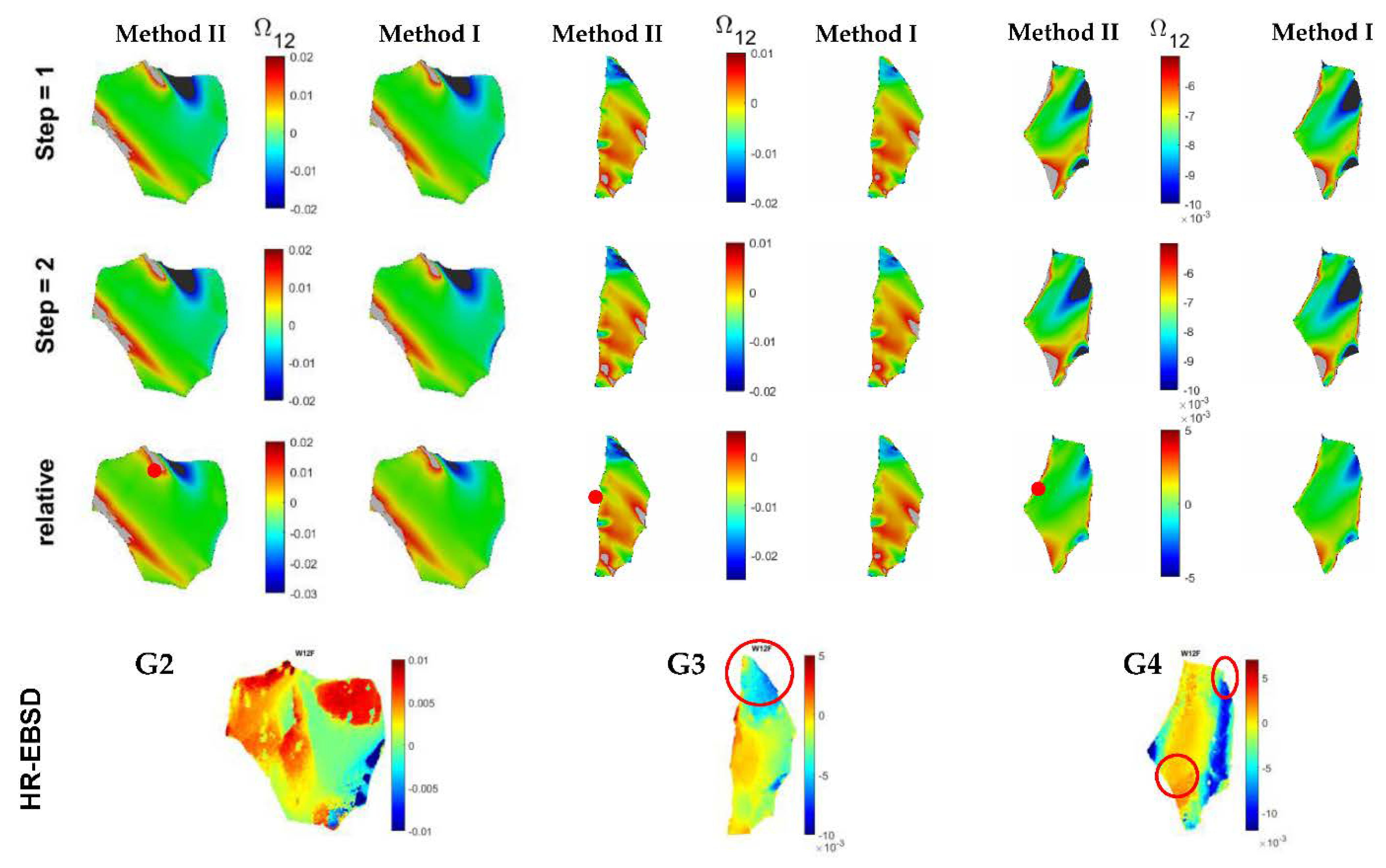
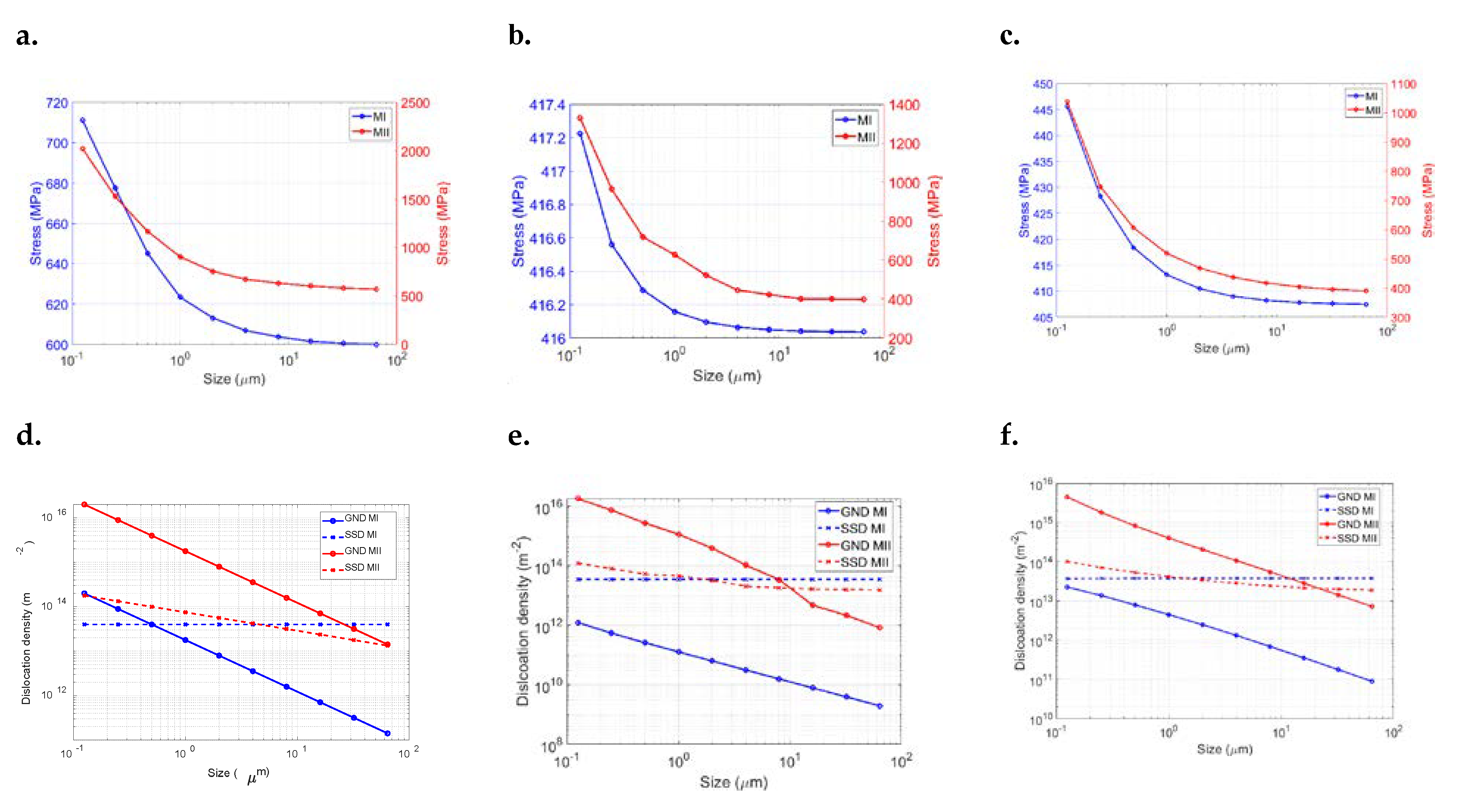
| Prism | Basal | Pyramidal | ||
|---|---|---|---|---|
| n | 20 | 20 | 20 | |
| 3.5 × 10−4 | 3.5 × 10−4 | 1.0 × 10−4 | ||
| (self) | 1 | 1 | 1 | |
| (t = prism) | 1 | 1 | 0 | |
| (t = basal) | 1 | 1 | 0 | |
| (t = pyramidal) | 0 | 0 | 1 | |
| Burgers vector (nm) | 0.323 | 0.323 | 0.608 | |
| 0.109 | 0.146 | 0.292 | ||
| 95 | 135 | 266 | ||
| MI | 0.07 | 0.07 | 0.30 | |
| 5 | 5 | 10 | ||
| MII | 0.05 | 0.05 | 0.30 | |
| 5 | 5 | 10 | ||
| Grain ID | GND Method | Cumulative Resolved Shear Strain | GND Density m−2 | |||||
|---|---|---|---|---|---|---|---|---|
| Prism | Basal | Pyr | Prism | Basal | Pyr | Total | ||
| 1 | I | 4.8 × 10−2 | 3.6 × 10−3 | <10−4 | 1.6 × 1011 | 1.5 × 109 | 1.3 × 106 | 1.6 × 1011 |
| II | 4.4 × 10−2 | 2.4 × 10−3 | <10−4 | 3.8 × 1011 | 3.8 × 1011 | 2.1 × 1012 | 2.9 × 1012 | |
| 2 | I | 2.4 × 10−2 | 1.2 × 10−3 | <10−4 | 3.7 × 109 | 1.4 × 108 | 4.1 × 105 | 3.9 × 109 |
| II | 2.3 × 10−2 | 1.1 × 10−3 | <10−4 | 1.8 × 1011 | 1.8 × 1011 | 9.1 × 1011 | 9.5 × 1011 | |
| 3 | I | 7.0 × 10−2 | 3.2 × 10−2 | <10−4 | 1.2 × 1010 | 1.4 × 1010 | 4.5 × 106 | 2.6 × 1010 |
| II | 6.9 × 10−2 | 3.0 × 10−2 | <10−4 | 1.9 × 1012 | 1.9 × 1012 | 8.8 × 1012 | 1.3 × 1013 | |
| 4 | I | 1.1 × 10−1 | 5.5 × 10−3 | <10−4 | 7.7 × 1010 | 5.1 × 109 | 9.2 × 107 | 8.2 × 1010 |
| II | 1.2 × 10−1 | 5.3 × 10−3 | <10−4 | 2.1 × 1012 | 2.1 × 1012 | 1.2 × 1013 | 1.6 × 1013 | |
| 5 | I | 2.4 × 10−2 | 1.2 × 10−3 | 1.2 × 10−4 | 2.6 × 109 | 1.2 × 109 | 4.5 × 108 | 4.3 × 109 |
| II | 2.3 × 10−2 | 0.9 × 10−3 | 1.1 × 10−4 | 4.2 × 1011 | 4.2 × 1011 | 2.5 × 1012 | 3.3 × 1012 | |
| Implementation | Lower-order non-local CPFE | Both methods can be implemented, but the implementation of Method I is more straightforward than Method II |
| Higher-order non-local CPFE | Only Method I | |
| Performance | Total GND density | Results from Method II are closer to those measured with HR-EBSD. |
| GND density on each slip system | Method I: the calculated values are proportional to the cumulative slip for each slip variant Method II: almost equal for all slip systems |
Publisher’s Note: MDPI stays neutral with regard to jurisdictional claims in published maps and institutional affiliations. |
© 2021 by the authors. Licensee MDPI, Basel, Switzerland. This article is an open access article distributed under the terms and conditions of the Creative Commons Attribution (CC BY) license (https://creativecommons.org/licenses/by/4.0/).
Share and Cite
Sedaghat, O.; Abdolvand, H. Strain-Gradient Crystal Plasticity Finite Element Modeling of Slip Band Formation in α-Zirconium. Crystals 2021, 11, 1382. https://doi.org/10.3390/cryst11111382
Sedaghat O, Abdolvand H. Strain-Gradient Crystal Plasticity Finite Element Modeling of Slip Band Formation in α-Zirconium. Crystals. 2021; 11(11):1382. https://doi.org/10.3390/cryst11111382
Chicago/Turabian StyleSedaghat, Omid, and Hamidreza Abdolvand. 2021. "Strain-Gradient Crystal Plasticity Finite Element Modeling of Slip Band Formation in α-Zirconium" Crystals 11, no. 11: 1382. https://doi.org/10.3390/cryst11111382





